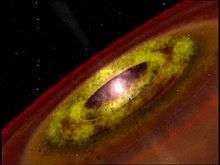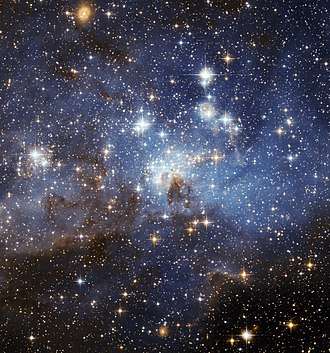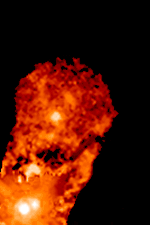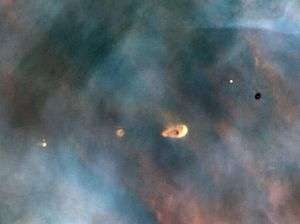T Tauri star
T Tauri stars (TTS) are a class of variable stars that are less than about ten million years old.[1] This class is named after the prototype, T Tauri, a young star in the Taurus star-forming region. They are found near molecular clouds and identified by their optical variability and strong chromospheric lines. T Tauri stars are pre-main-sequence stars in the process of contracting to the main sequence along the Hayashi track, a luminosity–temperature relationship obeyed by infant stars of less than 3 solar masses (M☉) in the pre-main-sequence phase of stellar evolution. It ends when a star of 0.5 M☉ develops a radiative zone, or when a larger star commences nuclear fusion on the main sequence.

| Star formation |
|---|
 |
| Object classes |
| Theoretical concepts |
History
While T Tauri itself was discovered in 1852, the T Tauri class of stars were initially defined by Alfred Harrison Joy in 1945.[2]
Characteristics
T Tauri stars comprise the youngest visible F, G, K and M spectral type stars (<2 M☉). Their surface temperatures are similar to those of main-sequence stars of the same mass, but they are significantly more luminous because their radii are larger. Their central temperatures are too low for hydrogen fusion. Instead, they are powered by gravitational energy released as the stars contract, while moving towards the main sequence, which they reach after about 100 million years. They typically rotate with a period between one and twelve days, compared to a month for the Sun, and are very active and variable.
There is evidence of large areas of starspot coverage, and they have intense and variable X-ray and radio emissions (approximately 1000 times that of the Sun). Many have extremely powerful stellar winds; some eject gas in high-velocity bipolar jets. Another source of brightness variability are clumps (protoplanets and planetesimals) in the disk surrounding T Tauri stars.

Their spectra show a higher lithium abundance than the Sun and other main-sequence stars because lithium is destroyed at temperatures above 2,500,000 K. From a study of lithium abundances in 53 T Tauri stars, it has been found that lithium depletion varies strongly with size, suggesting that "lithium burning" by the P-P chain during the last highly convective and unstable stages during the later pre–main sequence phase of the Hayashi contraction may be one of the main sources of energy for T Tauri stars. Rapid rotation tends to improve mixing and increase the transport of lithium into deeper layers where it is destroyed. T Tauri stars generally increase their rotation rates as they age, through contraction and spin-up, as they conserve angular momentum. This causes an increased rate of lithium loss with age. Lithium burning will also increase with higher temperatures and mass, and will last for at most a little over 100 million years.
The P-P chain for Lithium burning is as follows
It will not occur in stars with less than sixty times the mass of Jupiter (MJ). In this way, the rate of lithium depletion can be used to calculate the age of the star.
Types
Several types of TTSs exist:[3]
- Classical T Tauri star (CTTS)
- Weak-line T Tauri star (WTTS)
- Naked T Tauri star (NTTS), which is a subset of WTTS.

Roughly half of T Tauri stars have circumstellar disks, which in this case are called protoplanetary discs because they are probably the progenitors of planetary systems like the Solar System. Circumstellar discs are estimated to dissipate on timescales of up to 10 million years. Most T Tauri stars are in binary star systems. In various stages of their life, they are called Young Stellar Objects (YSOs). It is thought that the active magnetic fields and strong solar wind of Alfvén waves of T Tauri stars are one means by which angular momentum gets transferred from the star to the protoplanetary disc. A T Tauri stage for the Solar System would be one means by which the angular momentum of the contracting Sun was transferred to the protoplanetary disc and hence, eventually to the planets.
Analogs of T Tauri stars in the higher mass range (2–8 solar masses)—A and B spectral type pre–main-sequence stars, are called Herbig Ae/Be-type stars. More massive (>8 solar masses) stars in pre–main sequence stage are not observed, because they evolve very quickly: when they become visible (i.e. disperses surrounding circumstellar gas and dust cloud), the hydrogen in the center is already burning and they are main sequence objects.
Planets
Planets around T Tauri stars include:
- HD 106906 b around an F-type star
- 1RXS J160929.1−210524 around a K-type star
- Gliese 674 b around an M-type star
- V830 Tau b around an M-type star
- PDS 70b around a K-type star
Can Mature Star Systems with "hot Jupiter" Planets Act Like T Tauri Systems?
In 2008, a team of astronomers first described how as the exoplanet orbiting HD 189733 A reaches a certain place in its orbit, it causes increased stellar flaring. In 2010, a different team found that every time they observe the exoplanet at a certain position in its orbit, they also detected X-ray flares. Theoretical research since 2000 suggested that an exoplanet very near to the star that it orbits may cause increased flaring due to the interaction of their magnetic fields, or because of tidal forces. In 2019, astronomers analyzed data from Arecibo Observatory, MOST, and the Automated Photoelectric Telescope, in addition to historical observations of the star at radio, optical, ultraviolet, and X-ray wavelengths to examine these claims. They found that the previous claims were exaggerated and the host star failed to display many of the brightness and spectral characteristics associated with stellar flaring and solar active regions, including sunspots. Their statistical analysis also found that many stellar flares are seen regardless of the position of the exoplanet, therefore debunking the earlier claims. The magnetic fields of the host star and exoplanet do not interact, and this system is no longer believed to have a "star-planet interaction."[4] Some researchers had also suggested that HD 189733 accretes, or pulls, material from its orbiting exoplanet at a rate similar to those found around young protostars in T Tauri star systems. Later analysis demonstrated that very little, if any, gas was accreted from the "hot Jupiter" companion, making the system unlike a protostar system. An analysis of the variability in the brightness of HD 189733 A found that its brightness changes more like that of a mature star, as opposed to a young, heavily spotted T Tauri star embedded within an accretion disk. [5]
See also
- Orion variable
- P Cygni profile
References
- Appenzeller, I; Mundt, R (1989). "T Tauri stars". The Astronomy and Astrophysics Review. 1 (3–4): 291. Bibcode:1989A&ARv...1..291A. doi:10.1007/BF00873081.
- Joy, Alfred H. (1945). "T Tauri Variable Stars". The Astrophysical Journal. 102: 168–195. Bibcode:1945ApJ...102..168J. doi:10.1086/144749.
- Scott J. Wolk (1996). "T Tauri Stars, Naked and Otherwise". Retrieved 2018-03-14.
- Route, Matthew (February 10, 2019). "The Rise of ROME. I. A Multiwavelength Analysis of the Star-Planet Interaction in the HD 189733 System". The Astrophysical Journal. 872 (1): 79. arXiv:1901.02048. Bibcode:2019ApJ...872...79R. doi:10.3847/1538-4357/aafc25.
- Route, Matthew; Looney, Leslie (December 20, 2019). "ROME (Radio Observations of Magnetized Exoplanets). II. HD 189733 Does Not Accrete Significant Material from Its Exoplanet Like a T Tauri Star from a Disk". The Astrophysical Journal. 887 (2): 229. arXiv:1911.08357. Bibcode:2019ApJ...887..229R. doi:10.3847/1538-4357/ab594e.
- Discussion of V471 Tauri observations and general T-Tauri properties, Frederick M. Walter, Stony Brook University, April 2004
- An empirical criterion to classify T Tauri stars and substellar analogs using low-resolution optical spectroscopy, David Barrado y Navascues, 2003